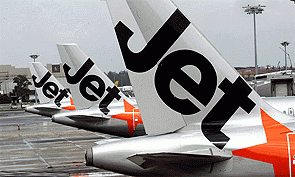
By Benje Patterson*

Qantas’s recently released financial results show that Jetstar lost market share to Air New Zealand over the closing stages of 2013.
According to my estimates, Jetstar’s share of the New Zealand domestic market fell to 16.8%* in the December half year, down from a peak of 17.9% in the six months to June.
Despite this recent wobble, Jetstar’s rapid growth over the past few years (and intense competition with Air New Zealand) has still significantly helped improve regional air connectivity in New Zealand and in turn boost spending by domestic visitors in regions on main-trunk airline routes.
In a previous article, I described why air connectivity is important for regional New Zealand.
My conclusions essentially stemmed from the idea that the availability of reliable regional air travel helps support entrepreneurial activity by providing businesses with more efficient access to markets, people, ideas, and capital.
This connectivity can in turn assist regions in attracting businesses and skilled staff to relocate to their area in the first place.
Furthermore, air connectivity’s important role in promoting regional tourism should not be overlooked.
Despite passenger numbers on Jetstar’s domestic flights over the six months to December falling 1.9% from a year earlier, regional air connectivity in New Zealand still increased over the same period thanks to moderate growth in Air New Zealand’s domestic passenger numbers (up 2.7%).
Furthermore, Jetstar’s recent wobble must be put in perspective, as it comes after 3.5 years of double-digit annual growth.
As a result of this growth, regional air connectivity in New Zealand has still improved significantly since Jetstar entered the New Zealand domestic market in June 2009.
Over the year to June 2010, the first full year in which Jetstar operated domestically, there were around 9.2 million domestic passenger movements in New Zealand – 1.2 million of these movements were on Jetstar flights, while 8.0 million were on Air New Zealand flights.
However, by December 2013, the annual running total of domestic passenger movements had reached 10.7 million.
This 16% growth in annual domestic passenger movements over the past 3.5 years was driven by incredible 57% growth in Jetstar passenger numbers, while the number flying with Air New Zealand rose a healthy 9.9% over the same period. These numbers highlight the improvements to regional air connectivity that have followed Jetstar’s injection of competition into the New Zealand domestic air travel market.
This competition has increased passenger movements by bringing affordable air travel within the budgets of a wider range of businesses and households.
Quantifying the economic effects of this improving air connectivity is difficult, but indicators of regional domestic spending behaviour do show that regions surrounding main-trunk airports (where Jetstar and Air New Zealand compete head-to-head[1]) have seen rapid growth in retail, accommodation, and hospitality spending.
According to MBIE’s regional tourism estimates, annual spending by domestic travellers (both business and leisure) rose rapidly in Auckland region, Wellington region, Canterbury, and Otago over the four years to March 2013 (up 6.0%, 20%, 9.6%, and 15% respectively).
In comparison, spending by domestic visitors to other regions rose by a more sedate 4.2% over the same period.
Data on domestic guest nights tells a similar story.
Although regional connectivity may not have been the only factor driving these spending and accommodation trends, the figures are at least consistent with my claim that the tourism industry across regional New Zealand is a benefactor.
Regardless of whether you are an Air New Zealand loyalist, or just choose whichever airline is cheapest, it is to be hoped that Jetstar’s recent set back is not the beginning of a slow decline for the airline.
After all, for consumers and businesses alike, the competition between these two airlines is vital for keeping domestic air travel prices low and regional air connectivity high. Even in regional centres where Jetstar does not fly, a lid is still kept on Air New Zealand pricing by factors such as the proximity of main-trunk airports with low-cost connections and even the threat of Jetstar investing in its own regional turboprop capacity.
--------------------------------------------------------------------------------------------
* Those of you who saw the Qantas’s half-year result may be wondering why my estimate of Jetstar’s market share is significantly less than the airline’s own estimate. My market share estimate (16.8%), compares to Jetstar’s claim that the airline has cornered 21.2% of the domestic market. The reason behind this difference is that Jetstar calculates market share using the proportion of total domestic revenue passenger kilometres flown on Jetstar flights, whereas I calculate market share using the share of total domestic passenger numbers carried by the airline.
Jetstar prefers to focus on revenue passenger kilometres because they give a high weighting to the airline’s longer main-trunk routes. However, although this methodology adheres to standard international practice, the calculations underweight many of Air New Zealand’s short, but well-patronised, regional routes. As a result, for economic analysis purposes, underlying passenger numbers are a more appropriate metric, as they clearly show movements of people between regions and can, consequently, help quantify regional air connectivity.
--------------------------------------------------------------------------------------------
[1] Main-trunk airports where both Jetstar and Air New Zealand operate domestic services are Auckland, Wellington, Christchurch, Dunedin, and Queenstown.
--------------------------------------------------------------------------------------------
Benje Patterson is an economist at Infometrics. He is a shareholder in Air New Zealand. You can contact him here »
3 Comments
Jetstar is the only thing stopping Air NZ price gouging - it needs to be supported with all trips (provided cost effective) other than critical business trips.
Huh?
Why should Jetstar be supported at all costs?
They chery pick main trunk routes only - they have no comittment to regional NZ where its harder to sustain a profitable business and yet pay a huge dividend back to QANTAS on the back of operating on the main trunks - where is their hard graft??
Jetstar provide competition - so we don't just have a monopoly Air NZ who price gouges. Both need to be profitable to be sustainable.
Cometition seems to always start with cherry picking the profitable.

We welcome your comments below. If you are not already registered, please register to comment.
Remember we welcome robust, respectful and insightful debate. We don't welcome abusive or defamatory comments and will de-register those repeatedly making such comments. Our current comment policy is here.